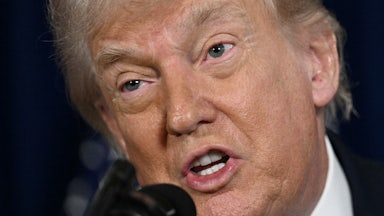Joe Biden reminded us he was still president on Sunday by pardoning his son, Hunter. This was, as TNR’s Matt Ford rightly pointed out, “a quintessentially corrupt act.” But I don’t agree with Ford’s more sweeping conclusion that Biden’s “has become a failed presidency.” On economic policy, the Biden administration was successful, even transformative, as Nicholas Lemann noted in The New Yorker a week before Election Day. And on Tuesday Biden reminded us that he’s still guiding economic policy wisely when he announced a proposed new regulation concerning disabled people who are paid below the minimum wage.
During this season of recriminations, many Democrats suggest that it’s disrespectful and elitist to point out that voters who judged the economy in terrible shape were wrong. Is it also disrespectful and elitist to point out that, according to a Yahoo News/YouGov poll, the proportion of Republican voters who said the economy was “getting worse” fell after Election Day from 74 percent to 48 percent? Or that, according to Gallup, economic confidence rose nine percentage points after the election, while the proportion of voters who judged the economy the country’s most urgent problem fell by 10 percentage points?
Those same Democrats who scold economic journalists for reporting truthfully about the economy don’t hesitate to affirm that the 49.97 percent plurality that cast its vote for Donald Trump got played for suckers. They got played for suckers on economic realities too.
One economic reality that isn’t so great is that employers can get away with paying disabled people $3.50 per hour or less. Minimum wage establishes a federal hourly minimum of $7.25, which is paltry; disabled people usually get paid less than half that amount, which is nobody’s idea of a living wage. Nearly 5 percent get paid 25 cents per hour or less. The Biden Labor Department now proposes ending this injustice.
The Fair Labor Standards Act, which established a federal minimum wage in 1938, has always allowed for exceptions for disabled workers. The provision was originally included with wounded veterans in mind, but today more than 90 percent of those receiving the disabled subminimum are mentally disabled. To obtain an exception, an employer must receive a waiver from the Labor Department. More than 90 percent of these waivers go to community rehabilitation nonprofits, but they also go to fast food establishments, grocery stores, schools, and hospitals, where the disabled are employed as groundskeepers, janitors, and food service workers.
The program has become less popular over time, partly because state and local governments often judge the subminimum wage discriminatory, and partly because a 2014 law narrowed the circumstances under which disabled workers could be paid subminimum wage. The Covid epidemic also reduced enrollment. As a consequence, the total number of employers who possessed such waivers fell from 5,612 in 2001 to 3,117 in 2010 to 801 this past May. The number of disabled workers participating in the program fell during that time from 424,000 to 40,579.
The disabled subminimum was implemented originally to create employment opportunities for this group. The Labor Department argues, persuasively, that such opportunities have now grown substantially, especially since passage in 1990 of the Americans With Disabilities Act, with more than twice as many mentally disabled people now paid minimum wage or above compared to those paid subminimum wage. Paying disabled workers a subminimum wage once made sense as a means to encourage employers to hire them, but the practice has outlived its usefulness.
The other group that employers can get away with paying subminimum wage are tipped workers. During the 2024 campaign, Kamala Harris proposed eliminating the $2.13 tipped hourly minimum. (More regrettably, she also endorsed Trump’s idiotic proposal to eliminate taxes on tips.) The Biden administration in 2021 narrowed the circumstances under which workers could be paid the tipped subminimum, reversing a Trump-era rule that increased use of the tipped subminimum, at a cost to workers that the Economic Policy Institute estimated at $700 million annually. In August, the regulation-unfriendly Fifth Circuit Court vacated the Biden rule, citing its expanded authority to legislate from the bench under the Supreme Court’s ruinous Loper Bright ruling two months earlier (which ended the 40-year doctrine, known as Chevron deference, by which judges were expected to recognize the superior expertise of regulatory agencies).
That Supreme Court might also be called the Trump Court, and Trump is no likelier to favor eliminating the subminimum wage for disabled workers than for tipped workers. Instead, Trump will almost certainly side with the eight Republican House members, led by Virginia Fox, chair of the Education and the Workforce Committee, who a year ago wrote acting Labor Secretary Julie Su urging her to “protect and preserve employment opportunities for individuals with disabilities” by paying them peanuts. (Trump has never been especially clear on whether he supports a federal minimum wage at all.) Since there isn’t enough time for Biden’s proposed rule to be finalized before Trump’s inauguration, it will likely get stashed in that same government warehouse where Indiana Jones’s Ark of the Covenant has gathered dust since 1936. This is what you voted for, America, and (in the choice phrasing of H.L. Mencken) you’re going to get it good and hard.






